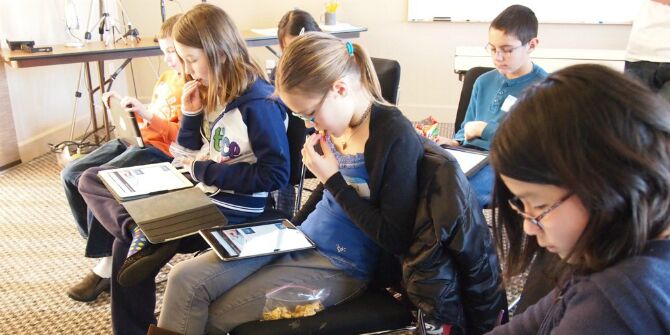 LSE’s Mariya Stoilova, Professor Sonia Livingstone, and Sheila Donovan worked with the UK-based NSPCC to investigate how children’s helplines measure their effectiveness.
LSE’s Mariya Stoilova, Professor Sonia Livingstone, and Sheila Donovan worked with the UK-based NSPCC to investigate how children’s helplines measure their effectiveness.
The work of child helplines is vital for reducing children’s risk of harm and vulnerability, and improving child protection and wellbeing. It is estimated that globally child helpline services take around 9 million calls annually. Child helplines are recognised as a key component of child protection services that contribute to creating accessible and child-friendly reporting systems and can help to ensure the implementation of child rights. Understanding the evidence regarding the effectiveness of child helplines can inform improvements to helplines and related child protection mechanisms. In collaboration with NSPCC, we carried out a systematic evidence mapping, comprising an extensive search of 18 databases, which reviews the existing literature on the effectiveness of child helplines with a particular focus on identifying helpline outcomes and approaches to measuring effectiveness.
The findings report, launched today, is available here. It highlights a number of positive outcomes and challenges:
- Key positive outcomes include a competent, efficient and approachable service: the evidence demonstrates that helplines can achieve improvements in relation to a range of child outcomes, such as children’s wellbeing, self-confidence, levels of anxiety and distress, and ability to deal with their current situation. Help-seekers sometimes put more emphasis on emotional support, such as being listened to and understood, than on problem-solving. Children value being able to talk to professionals who are knowledgeable and can be trusted, being able to discuss issues of concern, and feeling welcome.
- While the overall effects are generally positive, helpline effectiveness varies depending on the outcomes measured: fewer effects are observable in relation to skill development or changes in individual, family and social behaviour and practice. This may be due to the nature of the service offered or to the methodological challenges in capturing these effects. Not all users see the same positive results – some experience no effect or even negative outcomes. The children who are worse off after using helpline services are usually those who are unable to achieve the outcomes they expect, who are unhappy with the advice and help offered or who find that, while the advice is good, it is difficult to follow. Setting realistic and measurable helpline outcomes that capture the service performance can help to identify gaps and improve support, particularly for the children who experience the least benefits.
- There is an extended helpline support via digitally-mediated services which offers distinct benefits: online services are usually seen as more accessible (for those with internet access) as they have no geographical or time boundaries. Arguably, for some they can offer greater emotional safety and security due to the reduced emotional proximity to the counsellor, can provide greater privacy and anonymity, and a better opportunity to plan the interaction. This makes online support preferred among children who feel uncomfortable contacting a telephone helpline, particularly those with more complex and emotionally charged issues, LGBTQ youth, or those struggling with mental health issues or with a speech impairment. However, particular challenges arise from online communication, including the difficulty of recognising distress due to the lack of non-verbal and paralinguistic information (expression, voice, intonation, pauses), the need to employ compensatory strategies (e.g., emoticons, expressing emotions in text, discussing misunderstanding if it occurs) and digital inequalities related to access and skills.
- The main strength of the evidence base is that it represents children’s concerns and issues in a comprehensive way: most child helpline evaluations provide a good overview of the key issues children face, often drawing on case studies that vividly document children’s experiences. Some helplines particularly prioritise child representation, advocacy and rights and others provide ‘on-demand’ child support and evidence in response to a particular socially relevant issue. These efforts to provide evidence of the issues of concern to children themselves are important as they can help to open up the decision-making process and ensure children’s issues are represented at policy level.
- Circulation of good practice: effective collaboration within the sector – with referral agencies, educational and governmental institutions and the wider public– is often mentioned as key to effective child protection. Still, there is little evidence related to effects occurring at the level of family, community, cross-agency networks or society as a whole. Given substantial efforts to create change at all these levels, these evidence gaps are most likely the result of methodological difficulties to attribute such effects. Addressing these challenges may require collaborative evaluations, along with tracking longer-term impact and even establishing evaluation standards across the sector.
- Helplines generally strive to monitor their performance and use evidence to improve their support to children: a wide range of evidence-gathering and evaluation methods exists, from small-scale micro studies to more comprehensive multi-method designs, and from single-point ‘snapshots’ to comparative design studies with a longitudinal focus. While some studies rely on theoretically and empirically informed designs and map the organisational aims onto the service outcomes, many have a patchier approach and do not always draw on clearly defined outcomes in their assessments.
- The helpline sector faces substantial challenges in evaluating its effectiveness: this is because of both the struggles of individual helplines (often small organisations) to carry out comprehensive and robust evaluations and the lack of established and recognised models and outcome measures within the sector. Other challenges reflect the nature of the work itself: (1) the brief and confidential contact poses challenges to measuring outcomes and following up with service users, making particularly long-term effects hard to establish and demonstrate; (2) better outcomes data often means more intrusive research methods, which may be unsuitable for children – especially those who have self-identified as needing helpline support; (3) demonstrating the direct link between positive outcomes and helpline support is difficult in the light of the diversity of factors (behavioural, psychological, socioeconomic, use of other services) that may influence child outcomes; (4) the prevention of negative effects is particularly hard to measure and demonstrate as is impact change in social trends (e.g., in the incidence of child sexual abuse, violence, bullying, suicide, etc.).
In spite of these challenges the review outlined a number of good practice examples and approaches to overcoming barriers to effectiveness. Key lessons include:
- Using multiple measures and indicators: one of the strengths of the evaluations included in the review relates to the use of mixed methods to demonstrate the effectiveness of the service. Given the sensitive settings in which helplines operate, the number of issues raised and the various channels of support that are used at present, combining a range of methods, including both quantitative and qualitative measures, can provide stronger evidence.
- Quality of evidence: it might be beneficial to distinguish between ‘hard’ and ‘soft’ outcomes and to use different types of evidence to demonstrate effectiveness. Using a combination of some less robust quality data that a helpline can gather longitudinally and a single high-quality evaluation can offer an effective approach to demonstrating effectiveness.
- Using standardised measures: the use of standardised measures with established reliability, validity and applicability to children is a good way of producing robust evidence of effectiveness.
- Mapping aims, outcomes and measures: having a clear model of how the organisational aims match the desired outcomes and how the evidence can support the demonstration of effectiveness is crucial.
For more details and case studies, read the full report published by NSPCC as part of the Impact and Evidence series.
This article represents the views of the authors, and not the position of the LSE Media Policy Project, nor of the London School of Economics and Political Science.





